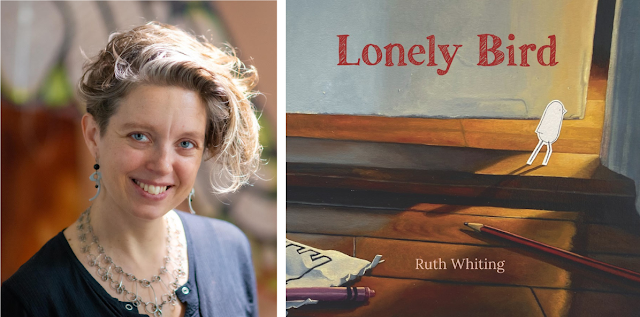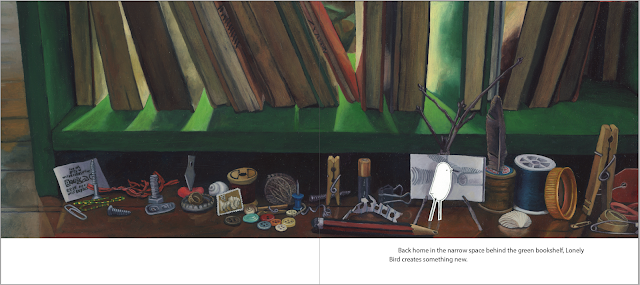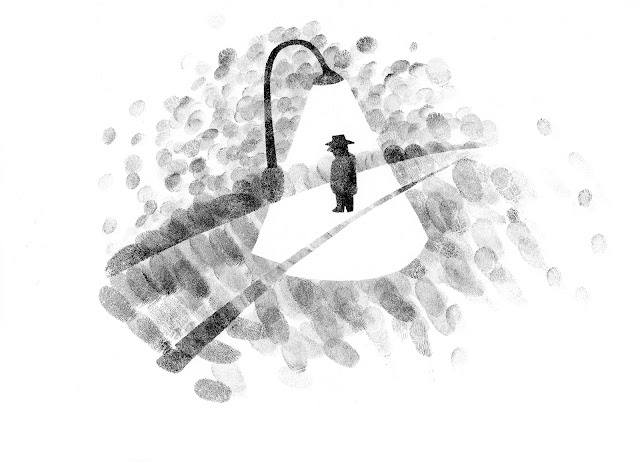I recently talked to author-illustrator Ruth Whiting about her highly unique mixed media illustration process for Lonely Bird. This story has lived inside Ruth for almost as long as she can remember, and it's an honor to have had the chance to pick her brain about creating a story out of a life-long idea. Enjoy a peek behind this fascinating curtain!
About the book:
A tiny paper bird shares a home with humans in this wondrously illustrated debut, introducing a sensitive, creative soul who ventures into the belly of the beast to rescue a new friend.
She's just a tiny slip of paper, a doodle cut in the shape of a bird. She isn't sure who made her or how she came to be, or if the family she lives with even knows she is there. She turns found objects into things of beauty--sometimes leaving them for the child of the house to discover--and invents riveting tales to tell to the wall outlet. And now, in her grandest adventure yet, the dauntless artist makes something thoroughly unexpected: a friend.
She's just a tiny slip of paper, a doodle cut in the shape of a bird. She isn't sure who made her or how she came to be, or if the family she lives with even knows she is there. She turns found objects into things of beauty--sometimes leaving them for the child of the house to discover--and invents riveting tales to tell to the wall outlet. And now, in her grandest adventure yet, the dauntless artist makes something thoroughly unexpected: a friend.
Let's talk Ruth Whiting!
LTPB: Where did the idea for Lonely Bird come from? What was the inspiration for this story?
I have always done drawings of birds in various forms. Lonely Bird actually came from a doodle I did on the back of a notebook when I was bored in a college class. It was such a nothing sketch, but somehow it jumped off the page as a complete character. Very quickly a story emerged about a liminal being who lives on the edge of our reality. This new character makes all the unexplained, seemingly accidental art you might find around your house. Chipped paint that looks like a face, a horse in the swirl of plaster on the bathroom wall, that kind of thing.
I have always done drawings of birds in various forms. Lonely Bird actually came from a doodle I did on the back of a notebook when I was bored in a college class. It was such a nothing sketch, but somehow it jumped off the page as a complete character. Very quickly a story emerged about a liminal being who lives on the edge of our reality. This new character makes all the unexplained, seemingly accidental art you might find around your house. Chipped paint that looks like a face, a horse in the swirl of plaster on the bathroom wall, that kind of thing.
Once she was in my head Lonely Bird would not let me rest until I made her book. Another core idea that came early-on was that Lonely Bird would go in and out of two-dimensional images, like pictures in a book almost as if there was no boundary between 2d and 3d worlds. The seed idea of a reserved, observant, artistic character who went on adventures blossomed from there. I have found myself embarking on a multi-decade examination of what it means to be a creative ever since.
I guess the answer to your question is really that Lonely Bird herself inspired this book. I was able to squeeze a reference to early Lonely Bird sketches into the half title page of book one. The very first words I ever associated with Lonely Bird were, “Lonely Bird, an elusive species usually seen at dusk.”
I am the first to admit that Lonely Bird is a deeply autobiographical pursuit. I am an artist who grew up across three different continents—always foreign, always an outsider. I reveled in being different, and relied heavily on my creative view of the world to help me navigate the confines of my reality. I see Lonely Bird kind of like a personification of the excess creativity that one finds on the edges of an artist’s life. I am not sure if she is ‘by my inner child’ or ‘for my inner child.’ But I do know I see the first glimmers of her in early pictures of myself.
Here I am in my grandparent’s book-filled house in Australia. I would not be surprised if Lonely Bird was hiding on those shelves.
When I conceived of the style I wanted to evoke, the vivid realism of a childhood memory and these kinds of scenes were very much what I drew upon.
LTPB: Did you always envision blending two very distinct art styles? How did the illustration techniques change as you fine-tuned the text?
Yes. As soon as I thought of making a book for Lonely Bird, I knew that this had to be the style. I am a classical trained oil painter and a student of art history so it was a rather natural choice. I was inspired by the idea of making a contemporary illuminated manuscript. Many of my early color choices, such as under-painting everything in cadmium red, came from my studies of techniques that have been used by artists for centuries.
I would say the style did not change as the text developed. It is almost the other way around. As I realized how much I can tell with images, I was able to make the prose more sparse.
I have had to learn to be very fluid in the sketching phase, and to not be attached to an image just because it is beautiful. I have folders full of images that are not in the book, even though they are wonderful images.
Yes. As soon as I thought of making a book for Lonely Bird, I knew that this had to be the style. I am a classical trained oil painter and a student of art history so it was a rather natural choice. I was inspired by the idea of making a contemporary illuminated manuscript. Many of my early color choices, such as under-painting everything in cadmium red, came from my studies of techniques that have been used by artists for centuries.
I would say the style did not change as the text developed. It is almost the other way around. As I realized how much I can tell with images, I was able to make the prose more sparse.
I have had to learn to be very fluid in the sketching phase, and to not be attached to an image just because it is beautiful. I have folders full of images that are not in the book, even though they are wonderful images.
My background is in fine art. Shifting toward illustration has taught me to be ruthless in the editing process and to really make sure that every image is communicating to maximum effect.
The magic really happens, though, when I paint the image. One of my favorite moments is when I am finally done with a painting and I scan it in and the final art replaces the placeholder source photo. The transformation from source photograph to finished painting is profound. I am really not going for photorealism. Photography is just a tool that allows me to get the layout right and gives me something to look at while I paint.
I have developed several other styles for different illustration projects that are not super realistic. Some that are quite loose, use inks or watercolor, and require no photography. I do hope to get to explore some different worlds. But for now I am very much in the grip of this particular kind of magical realism.
LTPB: What did you find most difficult in creating this book? What did you find most rewarding?
The photo shoots are an epic ordeal sometimes. My process is to sketch the idea for an image. Then, when
the book has been written and edited, and every page approved, I have to go out into the world and find a
way to get photographs of what I have imagined. The process is rather cinematographic—with tiny props and carefully scavenged household detritus. Sometimes I can shoot them right in my studio. More often I have to go somewhere and coordinate people which is always a bit stressful. Both my husband, Tim, and my son help a lot with this part of the process and are very supportive and understanding when I am stressing about getting a shot.
I work out all the elements I need and the composition in a rough sketch.
Then I set it up in real life. There is a lot of sitting on the floor, moving tiny things around, and taking hundreds of slightly different shots.
The photo shoots are an epic ordeal sometimes. My process is to sketch the idea for an image. Then, when
the book has been written and edited, and every page approved, I have to go out into the world and find a
way to get photographs of what I have imagined. The process is rather cinematographic—with tiny props and carefully scavenged household detritus. Sometimes I can shoot them right in my studio. More often I have to go somewhere and coordinate people which is always a bit stressful. Both my husband, Tim, and my son help a lot with this part of the process and are very supportive and understanding when I am stressing about getting a shot.
I work out all the elements I need and the composition in a rough sketch.
Then I set it up in real life. There is a lot of sitting on the floor, moving tiny things around, and taking hundreds of slightly different shots.
The most rewarding part is making the paintings. I love painting and these images are very satisfying. It is tedious and physically demanding, but I absolutely adore making the images come to life.
Seeing the transformation from sketch to photograph to painting never fails to amaze me.
LTPB: What did you use to create the illustrations in this book? Is this your preferred medium? How does your process change from book to book?
I use oil paint on gessoed paper to make the images. Lonely Bird is cut out of a different kind of paper and then stuck on to the image.
I have worked with a lot of different mediums, but oil paint holds a special place in my heart. I think my process very much evolves depending on the story and what works best. I have illustrated books with watercolor and using different ink techniques. The story determines the style for me.
I also work as a fine artist making large oil paintings that I show in galleries and museums. Tim Elverston and I have a design studio together called WindFire Designs where we make many different kinds of things. Most notably large-scale kinetic public art and kites. So, I get to paint all kinds of things that are often more abstract and about just color, which is a nice change from the obsessive detail of Lonely Bird.
Working on a giant painting of bread in our outdoor studio.
Right now I am totally consumed with working on Lonely Bird 2. That means many hours painting and a lot of photoshoot strategy. I have included some process shots for some behind-the-scenes insight. Book two has been an intense process that has required a great deal of model making. Here are just a few images of the lengths to which we go to get the right shots.
A fake book surrounded by stunt lonely birds. I make a Lonely Bird for each photograph so I generate a lot of these.
Yes, I did have to spend some time up a tree for a few shots.
Miniature papier-mâché. What am I making?
Never leave home without your twig ladder.
Tim and I are also working on a large-scale kinetic artwork that will go into a hospital that is being remodeled. It is always very exciting for us to collaborate like this. We have been working together since we met 23 years ago. It is always a pleasure to go from sketches to finished work. Our abilities combine in such interesting ways. Tim is all about structure and dreams up wonderful new frameworks for making dynamic Art. While I bring color to our work and help with developing overall vision and subtle narrative.
You can see a lot more about our work together on our website. Including videos that show the motion of our sculptures.
Well in some ways I think I have done that, although not in a direct way. But what a great question. I think I would love to see the surreal bent that Shawn Tan would bring to an autobiography. I love his work. I discovered him after I started showing early versions of Lonely Bird around and people said my painitngs reminded them of Shawn Tan. I could not be more flattered.
I have been fortunate to have many surreal moments in my life. Quite a few of which I have shared with Lonely Bird.
A big thank you to Ruth for taking time to explain her fascinating process! Lonely Bird published last month from Candlewick Press.
Special thanks to Ruth and Candlewick for use of these images!

This post contains affiliate links. For more information, visit my policies & disclosures page






























What a wonderful concept for a picture book! I love the idea of an unknown creature making the "accidental" art we sometimes notice. I just asked my library to purchase LONELY BIRD.
ReplyDelete